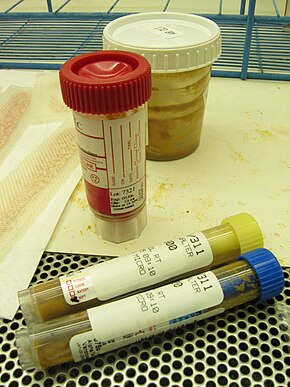Stool test: Difference between revisions
→Fecal occult blood test: missing ref |
→Fecal occult blood test: COPY content from Multitarget stool DNA screening test |
||
| Line 25: | Line 25: | ||
*Texture/consistency - formed |
*Texture/consistency - formed |
||
==Sreening== |
|||
==Fecal occult blood test== |
|||
One of the most common stool tests, the [[fecal occult blood test]] can be used to diagnose many conditions that cause bleeding in the [[gastrointestinal system]] including [[colorectal cancer]] or [[stomach cancer]].<ref>{{cite web|url=http://www.webmd.com/hw/colorectal_cancer/hw227116.asp|title=Fecal Occult Blood Test (FOBT)}}</ref> The [[American Cancer Society]] recommends screening with either DNA testing every 3 years, guaiac [[fecal occult blood test]], or [[fecal immunochemical test]] every year starting at age 50.<ref name="Smith RA 2015">{{cite journal|last1=Smith|first1=RA|last2=Manassaram-Baptiste|first2=D|last3=Brooks|first3=D|title=Cancer screening in the United States, 2015: a review of current American Cancer Society guidelines and current issues in cancer screening|journal=CA Cancer J Clin|date=2015|volume=65|issue=1|pages=30–54|display-authors=etal|doi=10.3322/caac.21261}}</ref> Other options include [[sigmoidoscopy]] or [[virtual colonoscopy]] (CT colonography) every five years or [[colonoscopy]] every 10 years.<ref>{{cite web|title=American Cancer Society recommendations for colorectal cancer early detection|url=http://www.cancer.org/cancer/colonandrectumcancer/moreinformation/colonandrectumcancerearlydetection/colorectal-cancer-early-detection-acs-recommendations|website=www.cancer.org|accessdate=14 July 2016}}</ref> |
One of the most common stool tests, the [[fecal occult blood test]] can be used to diagnose many conditions that cause bleeding in the [[gastrointestinal system]] including [[colorectal cancer]] or [[stomach cancer]].<ref>{{cite web|url=http://www.webmd.com/hw/colorectal_cancer/hw227116.asp|title=Fecal Occult Blood Test (FOBT)}}</ref> |
||
The [[American Cancer Society]] recommends screening with either DNA testing every 3 years, guaiac [[fecal occult blood test]], or [[fecal immunochemical test]] every year starting at age 50.<ref name="Smith RA 2015">{{cite journal|last1=Smith|first1=RA|last2=Manassaram-Baptiste|first2=D|last3=Brooks|first3=D|title=Cancer screening in the United States, 2015: a review of current American Cancer Society guidelines and current issues in cancer screening|journal=CA Cancer J Clin|date=2015|volume=65|issue=1|pages=30–54|display-authors=etal|doi=10.3322/caac.21261}}</ref> Other options include [[sigmoidoscopy]] or [[virtual colonoscopy]] (CT colonography) every five years or [[colonoscopy]] every 10 years.<ref>{{cite web|title=American Cancer Society recommendations for colorectal cancer early detection|url=http://www.cancer.org/cancer/colonandrectumcancer/moreinformation/colonandrectumcancerearlydetection/colorectal-cancer-early-detection-acs-recommendations|website=www.cancer.org|accessdate=14 July 2016}}</ref> |
|||
The [[U.S. Preventive Services Task Force]] published an updated colorectal cancer screening recommendation statement in 2016.<ref name="Bibbins-DomingoGrossman2016">{{cite journal|last1=Bibbins-Domingo|first1=Kirsten|last2=Grossman|first2=David C.|last3=Curry|first3=Susan J.|last4=Davidson|first4=Karina W.|last5=Epling|first5=John W.|last6=García|first6=Francisco A. R.|last7=Gillman|first7=Matthew W.|last8=Harper|first8=Diane M.|last9=Kemper|first9=Alex R.|last10=Krist|first10=Alex H.|last11=Kurth|first11=Ann E.|last12=Landefeld|first12=C. Seth|last13=Mangione|first13=Carol M.|last14=Owens|first14=Douglas K.|last15=Phillips|first15=William R.|last16=Phipps|first16=Maureen G.|last17=Pignone|first17=Michael P.|last18=Siu|first18=Albert L.|title=Screening for Colorectal Cancer|journal=JAMA|volume=315|issue=23|year=2016|pages=2564|issn=0098-7484|doi=10.1001/jama.2016.5989|pmid=27304597}}</ref> |
|||
The [[National Comprehensive Cancer Network]] (NCCN) published screening guidelines in 2016.<ref>{{cite web|last1=National Comprehensive Cancer Network|title=National Comprehensive Cancer Network|url=https://www.nccn.org/professionals/physician_gls/f_guidelines.asp#detection|website=NCCN GUIDELINES FOR DETECTION, PREVENTION, & RISK REDUCTION|accessdate=October 31, 2016}}</ref> |
|||
In 2016 the [[National Committee for Quality Assurance]] (NCQA) issued an update to the [[Healthcare Effectiveness Data and Information Set]] (HEDIS) for 2017.<ref>{{cite web|last1=National Committee for Quality Assurance|title=Healthcare Effectiveness Data and Information Set 2017 Volume 2: Technical Update|url=http://www.ncqa.org/Portals/0/HEDISQM/HEDIS2017/HEDIS%202017%20Volume%202%20Technical%20Update.pdf?ver=2016-10-03-114902-317}}</ref> |
|||
==Microbiology tests== |
==Microbiology tests== |
||
Revision as of 19:47, 21 September 2017
A stool test involves the collection and analysis of fecal matter to diagnose the presence or absence of a medical condition.
Gross (naked eye exam)
The patient and/or health care worker in the office or at the bedside is able to make some important observations.
- Color -
- Texture/consistency - formed
Sreening
One of the most common stool tests, the fecal occult blood test can be used to diagnose many conditions that cause bleeding in the gastrointestinal system including colorectal cancer or stomach cancer.[1]
The American Cancer Society recommends screening with either DNA testing every 3 years, guaiac fecal occult blood test, or fecal immunochemical test every year starting at age 50.[2] Other options include sigmoidoscopy or virtual colonoscopy (CT colonography) every five years or colonoscopy every 10 years.[3]
The U.S. Preventive Services Task Force published an updated colorectal cancer screening recommendation statement in 2016.[4]
The National Comprehensive Cancer Network (NCCN) published screening guidelines in 2016.[5]
In 2016 the National Committee for Quality Assurance (NCQA) issued an update to the Healthcare Effectiveness Data and Information Set (HEDIS) for 2017.[6]
Microbiology tests
Parasitic diseases such as ascariasis, hookworm, strongyloidiasis and whipworm can be diagnosed by examining stools under a microscope for the presence of worm larvae or eggs. Some bacterial diseases can be detected with a stool culture. Toxins from bacteria such as Clostridium difficile ('C. diff.') can also be identified. Viruses such as rotavirus can also be found in stools.[7]
Chemical tests
A fecal pH test may be used to determine lactose intolerance or the presence of an infection.[8] Steatorrhea can be diagnosed using a Fecal fat test that checks for the malabsorption of fat.[9]
Faecal elastase levels are becoming the mainstay of pancreatitis diagnosis.
See also
References
- ^ "Fecal Occult Blood Test (FOBT)".
- ^ Smith, RA; Manassaram-Baptiste, D; Brooks, D; et al. (2015). "Cancer screening in the United States, 2015: a review of current American Cancer Society guidelines and current issues in cancer screening". CA Cancer J Clin. 65 (1): 30–54. doi:10.3322/caac.21261.
- ^ "American Cancer Society recommendations for colorectal cancer early detection". www.cancer.org. Retrieved 14 July 2016.
- ^ Bibbins-Domingo, Kirsten; Grossman, David C.; Curry, Susan J.; Davidson, Karina W.; Epling, John W.; García, Francisco A. R.; Gillman, Matthew W.; Harper, Diane M.; Kemper, Alex R.; Krist, Alex H.; Kurth, Ann E.; Landefeld, C. Seth; Mangione, Carol M.; Owens, Douglas K.; Phillips, William R.; Phipps, Maureen G.; Pignone, Michael P.; Siu, Albert L. (2016). "Screening for Colorectal Cancer". JAMA. 315 (23): 2564. doi:10.1001/jama.2016.5989. ISSN 0098-7484. PMID 27304597.
- ^ National Comprehensive Cancer Network. "National Comprehensive Cancer Network". NCCN GUIDELINES FOR DETECTION, PREVENTION, & RISK REDUCTION. Retrieved October 31, 2016.
- ^ National Committee for Quality Assurance. "Healthcare Effectiveness Data and Information Set 2017 Volume 2: Technical Update" (PDF).
- ^ "Stool culture".
- ^ "Stool Acidity Test - MedicineNet.com".
- ^ "MedlinePlus Medical Encyclopedia: Fecal fat".

